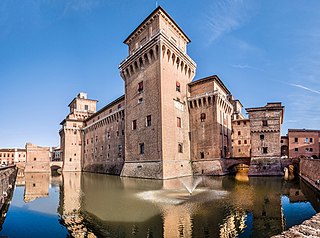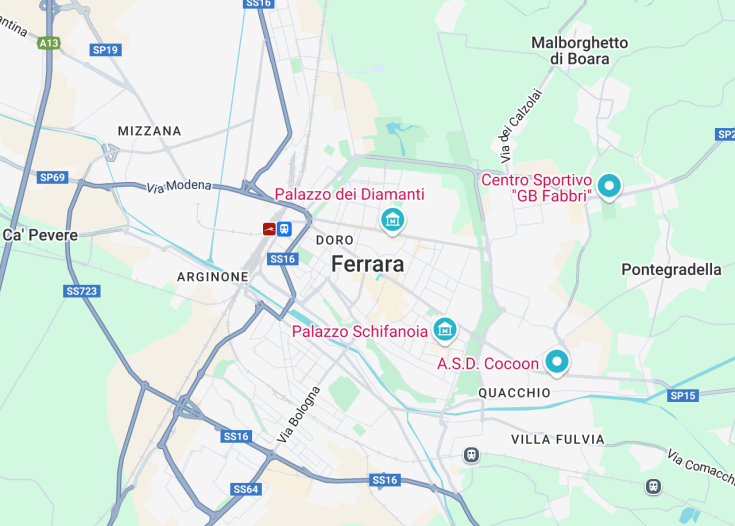Ferrara, a splendid city in Italy’s Emilia-Romagna region, is steeped in Renaissance history and famed for its artistic heritage. The Este family, who ruled Ferrara until the 16th century, left an indelible mark with palaces, churches, and the magnificent Castello Estense. The city’s urban landscape uniquely blends medieval and Renaissance architecture, earning its designation as a UNESCO World Heritage Site. Visitors are enchanted by its timeless beauty, cultural richness, and the quiet allure of its streets.
Plan your visit in the autumn to enjoy Ferrara’s captivating beauty with fewer crowds and pleasant weather, enhancing your experience of the city’s historical sites.
Don’t miss a chance to try traditional Ferrarese dishes like cappellacci di zucca, a delightful pasta filled with pumpkin, at a local trattoria for an authentic culinary experience.
Top things to do & see in Ferrara
Select the following sights and activities to discover best tickets and tours available in Ferrara.
Ferrara: A Renaissance Jewel of Italy
| Country | Italy |
| Time in Ferrara | GMT+1 |
| Language spoken | Italian |
| Population | 132,278 (source: ISTAT) |
| Currency | Euro (€, EUR) |
| Airports |
|
Ferrara, a splendid city in Italy’s Emilia-Romagna region, holds a rich history bonded with Renaissance culture and architectural heritage. This UNESCO-listetgoworld heritage site is renowned for its beautifully preserved cityscape, reflecting the opulence and creativity of its past. The city was a leading cultural centre in the 15th and 16th centuries, under the rule of the Este dukes, who welcomed painters, scholars, and poets that have bestowed the city with a lasting legacy of art and culture.
Ferrara’s layout is unique due to its urban planning which integrates medieval and Renaissance elements within its walls, influencing the development of many modern cities. Its broad streets and numerous palaces make it a testament to the greatness of the Renaissance era, paired gracefully with medieval structures. Among its treasures, the Castello Estense, with its moats, drawbridges, and dungeons, offers a glimpse into the regal aspirations and fears of the Este family, while the Palazzo dei Diamanti, named for its diamond-shaped marble blocks that make up its facade, houses prestigious art exhibitions.
The city is not only a haven for history enthusiasts but also for cyclists and pedestrians who enjoy the expansive pedestrian zones and bike paths that run through the town center. The city’s culinary scene reflects its rich agricultural surroundings, famous for traditional dishes such as Cappellacci di Zucca (pumpkin-filled pasta) and paired typically with a glass of robust, local Sangiovese wine.
Ferrara also serves as a gateway to the Po Delta, one of Italy’s leading ecotourism and birdwatching areas, highlighting the region’s natural beauty alongside its historical significance. This combination of historical heritage, active modern culture, and natural beauty ensures that Ferrara remains a captivating destination for international visitors and Italians alike.
Where is Ferrara?
Located in the northern part of Italy, within the Emilia-Romagna region, Ferrara lies between the Po River to the north and the Apennines to the south.
Distances:
| Route | Distance by car | Time by car |
|---|---|---|
| Venice to Ferrara | 108 km | 1hr 30min |
| Florence to Ferrara | 178 km | 2 hrs |
| Milan to Ferrara | 218 km | 2 hrs 15 min |
What is Ferrara famous for?
Ferrara is renowned for its impressive Renaissance and medieval architecture, particularly the Castello Estense and the city’s well-preserved ancient walls, which are among the most complete in Italy.
History
Before 700 AD: Early Settlement
The area now known as Ferrara shows evidence of human presence from as early as the Bronze Age. It became more significantly inhabited around the 6th century, when the Byzantines constructed a fortress at the site. This period marked the foundation of what would evolve into the modern city of Ferrara.
700-1200: Growth under the Exarchate of Ravenna
As part of the Exarchate of Ravenna, Ferrara was under Byzantine control and served as a strategic location in northern Italy. During this time, the city’s population began to grow substantially, setting the stage for its later significance during the medieval period.
1200-1500: The Rule of the Este Family
Ferrara entered its golden age under the rule of the Este family, starting around the 13th century. The Este dynasty transformed Ferrara into a cultural hub, attracting artists, scholars, and poets. The city flourished architecturally and economically, becoming renowned for its beauty and culturally vibrant atmosphere.
1500-1859: Renaissance Flourishing and Later Years
During the Renaissance, Ferrara continued to prosper under the Este rule. The addition of the University of Ferrara in 1391 bolstered the city’s reputation as a center of intellectual activity. However, after the Este line ended and Ferrara became part of the Papal States in 1598, its influence declined.
1860-Present: Modern Developments
Since becoming part of the unified Kingdom of Italy in 1860, Ferrara has modernized while preserving its historical heritage. Today, it balances its rich history with a dynamic presence in the agricultural and industrial sectors. Ferrara remains a tribute to its past, with its medieval and Renaissance architecture continuing to draw visitors from around the world.
Visit Ferrara
What to see and do in Ferrara
Ferrara, a splendid city of art and culture, offers a variety of attractions:
- The Este Castle, with its moat and drawbridges.
- The Cathedral of Saint George, renowned for its blend of Romanesque and Gothic styles.
- Palazzo dei Diamanti, which houses important art exhibitions.
- The medieval city walls that still encircle much of the city.
- Biking along the expansive city walls for a unique exploration of the area.
Annual Celebrations in Ferrara
Ferrara hosts numerous events throughout the year, celebrating its rich cultural heritage:
- The Palio di Ferrara, the oldest horse race in the world, held in May.
- Ferrara Balloons Festival, an international hot air balloon festival in September.
- Internazionale a Ferrara, a journalism festival held every October that gathers writers and journalists from around the world.
Best time to visit Ferrara
The ideal time to visit Ferrara is in the spring (April to June) or autumn (September to October), when the weather is mild and conducive to exploring the city’s outdoor and architectural wonders without the peak tourist crowds.
Is Ferrara worth visiting?
Ferrara is undoubtedly worth visiting, offering a rich tapestry of history, art, and culture. Its status as a UNESCO World Heritage site underscores its global importance. The city provides a unique glimpse into the past, manifested in its preservation of Renaissance architectural splendor and its ongoing cultural traditions like the Palio di Ferrara. Whether you are a history enthusiast, art lover, or simply looking for a picturesque and less-traveled Italian destination, Ferrara is a compelling choice.









